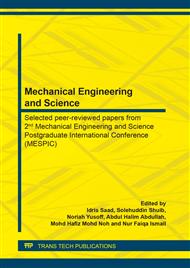[1]
Zainal Zakaria, Hamdzun Haron, Characterisation of local bone ash for bone china production, Jurnal Teknologi, Vol 66:1(2014), pp.25-34.
DOI: 10.11113/jt.v66.2157
Google Scholar
[2]
Nor Hayati Saad, Abdul Rahim M. Sahab, M. Moza M. Mohtar, Farrahshaida M. Salleh, Izdihar Tharazi, Juri Saedon, Formation of hollow shape porcelain by using a new integrated slip rotary moulding technique, Jurnal Teknologi, 76:6 (2015), p.49–53.
DOI: 10.11113/jt.v76.5673
Google Scholar
[3]
Abdul Rahim Mahamad Sahab, Nor Hayati Saad, Farrahshaida M.Salleh, Azlin Hamidi, Doll Said Ngah, Teng Wang Dung, In-tegrated process of ceramic slip using rotating technique, Trans Tech Publications, Switzerland (2016), Vol. 1133, pp.161-165.
DOI: 10.4028/www.scientific.net/amr.1133.161
Google Scholar
[4]
Abdul Rahim Mahamad Sahab, Nor Hayati Saad, Azlin Ha-midi, Farrahshaida M. Salleh, Doll Said Ngah, Teng Wang Dung, High solid content slip formulation and polymer based dispersant analysis for hollow porcelain product fabrication using rotary moulding, ICENS (2015).
DOI: 10.4028/www.scientific.net/amr.1133.161
Google Scholar
[5]
N.H. Saad, A.R.M. Sahab, M.H. Ibrahim, N. Rasid, The enhancement of CAD/CAM technology in ceramic industry, Third International Conference on Advanced Manufacturing Technology, (2004).
Google Scholar
[6]
R. Janssen, S. Scheppokat, N. Claussen, Tailor-made ceramic-based components – Advantages by reactive processing and advanced shaping techniques, European Ceramic Society. 28 (2008).
DOI: 10.1016/j.jeurceramsoc.2007.12.022
Google Scholar
[7]
K.M. Linqvist, E. Calstrom, Indirect solid freeform fabrication by binder assisted slip casting, European Ceramic Society. 25 (2005) pp.3539-3545.
DOI: 10.1016/j.jeurceramsoc.2004.10.013
Google Scholar
[8]
I. A.H. Al-Dawery, J.G.P. Binner, G. Tari, P. R. Jackson, W. R. Murphy, M. Kearns, Rotary moulding of ceramic hollow wares, European Ceramic Society, Vol.29 (2009), pp.887-891.
DOI: 10.1016/j.jeurceramsoc.2008.07.021
Google Scholar
[9]
Ruphal Mehta, Hollow ceramic components produced by rotary moulding cut costs, Material Worl Magazine, Jan (2007).
Google Scholar
[10]
R. J. Crawford, Rotational Moulding of Plastics, Wiley, (1992).
Google Scholar
[11]
Yin Zhang, Deshuang Kong and Xia Feng, Fabrication and properties ofporous β-tricalcium phosphate ceramics prepared using double slip casting method using slips with different viscosities, 38 (2012), pp.2991-2996.
DOI: 10.1016/j.ceramint.2011.11.078
Google Scholar
[12]
Y. Zhang, Y. Yokogawa and T. Kameyama, Influence of powder particle size 0f slurries on mechanical properties of porous hydroxyapatite ceramics, Key Eng. Mater. 284-286 (2005), pp.365-368.
DOI: 10.4028/www.scientific.net/kem.284-286.365
Google Scholar
[13]
Athena Tsetsekou, Christos Agrafiotis, Aggelos Milias, Opti-mization ofthe rheological properties of alumina for ceramic processing applications Part 1: Slip- casting, European Ceramic Society, Vol 21 (2001), pp.363-373.
DOI: 10.1016/s0955-2219(00)00185-0
Google Scholar
[14]
Giuliano Tari, Jose. F. Ferreira, Influence of solid loading on drying shrinkage behavior of slip cast bodies, European Ceramic Society, 13 Vol.18 (1998), pp.487-493.
DOI: 10.1016/s0955-2219(97)00161-1
Google Scholar
[15]
Soumen Maity and B.K Sarkar, Phase analysis and role of microstructure in the development of high strength porcelains, 24 (1998), 259-264.
DOI: 10.1016/s0272-8842(96)00079-x
Google Scholar
[16]
Soumen Maity and B.K Sarkar, Development of high-strength whiteware bodies, 16 (1996) pp.1083-1088.
Google Scholar
[17]
Kaili Lin, Jiang Chang, Jianxi Lu, Wei Wu and Yi Zeng, Properties of β-Ca3(PO4)2 bioceramics prepared using nano-size powders, 33 (2007), pp.979-985.
DOI: 10.1016/j.ceramint.2006.02.011
Google Scholar
[18]
R. Emadi, F. Tavangarian, S.I.R. Esfahani, A. Sheikhhosseini and M. Kharaziha, Nanostructured forsterite coating strengthens porous hydroxyapatite for bone tissue engineering, J. Am. Ceram. Soc. 93 (9) (2010), pp.2679-2683.
DOI: 10.1111/j.1551-2916.2010.03817.x
Google Scholar
[19]
K.C.B. Yeong, J. Wang and S.C. Ng. Fabricating densified hydroxyapatite ceramics from a precipitated precursor, Mater. Lett. 38 (3) (1999), pp.208-213.
DOI: 10.1016/s0167-577x(98)00160-8
Google Scholar
[20]
Data Sheet: Sodium Silicate Liquid Grade: 58BE (filter grade), Concord Chemicals Corporation SDN. BHD.
Google Scholar


